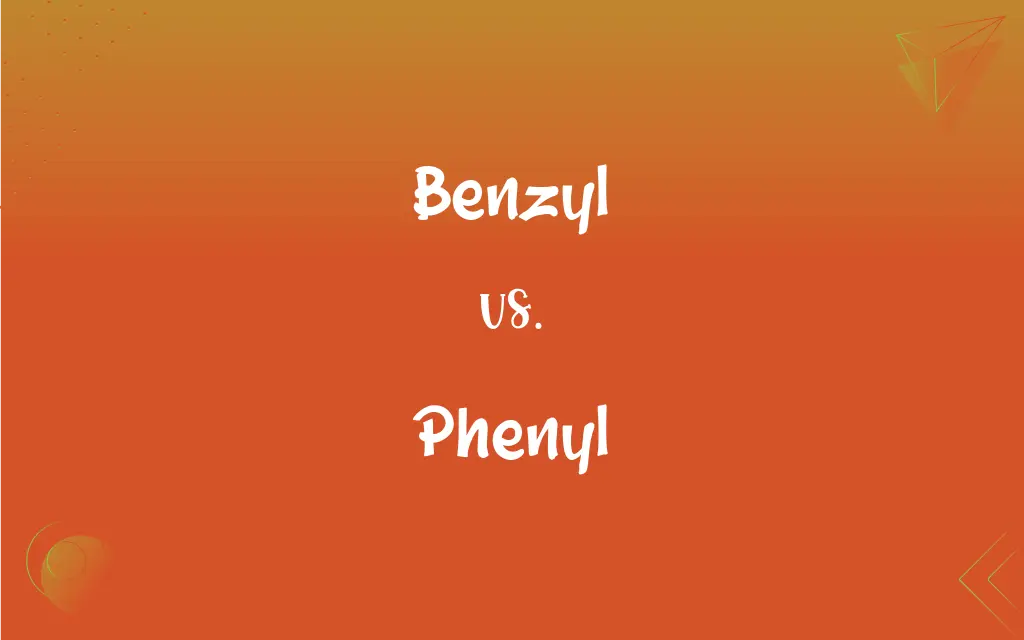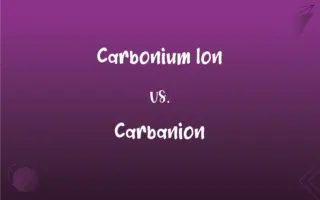Benzyl vs. Phenyl: What's the Difference?
Edited by Aimie Carlson || By Janet White || Published on December 20, 2023
Benzyl is a chemical group (C₆H₅CH₂) derived from toluene, while phenyl is a simpler aromatic ring (C₆H₅) derived from benzene.

Key Differences
Benzyl contains a phenyl ring attached to a CH₂ group, making it a larger and more complex structure. Phenyl, in contrast, is simply an aromatic ring without any additional atoms or groups attached.
In benzyl compounds, the extra CH₂ group often impacts chemical reactivity and properties. Phenyl compounds, lacking this CH₂ group, behave differently in chemical reactions.
Benzyl is derived from toluene, a methylated form of benzene, indicating its additional CH₂ group. Phenyl is directly derived from benzene, consisting only of the aromatic ring.
The presence of the CH₂ group in benzyl makes it less rigid and more reactive in certain chemical contexts. Phenyl, being a simpler structure, has a rigidity that influences its reactivity and interactions.
Benzyl is often used in organic chemistry to create a variety of compounds, including polymers and pharmaceuticals. Phenyl is commonly found in many organic compounds, playing a crucial role in the structure and function of these molecules.
ADVERTISEMENT
Comparison Chart
Chemical Structure
C₆H₅CH₂ (phenyl ring + CH₂ group)
C₆H₅ (phenyl ring only)
Derived From
Toluene (methylated benzene)
Benzene
Complexity
More complex due to additional CH₂ group
Simpler, consisting of only the aromatic ring
Reactivity
Different reactivity due to CH₂ group
Reactivity influenced by the aromatic ring alone
Usage in Chemistry
Used in creating polymers, pharmaceuticals
Found in various organic compounds
ADVERTISEMENT
Benzyl and Phenyl Definitions
Benzyl
A substituent in organic chemistry with specific reactivity due to its structure.
Benzyl acetate has a pleasant aroma and is used in perfumery.
Phenyl
A simple aromatic ring derived from benzene.
Phenyl groups are integral to the structure of many pharmaceuticals.
Benzyl
A chemical group consisting of a phenyl ring attached to a CH₂ group.
Benzyl chloride is used as an organic solvent.
Phenyl
A basic building block in organic chemistry, often used as a substituent.
The phenyl group contributes to the flavor of certain artificial sweeteners.
Benzyl
A functional group in organic chemistry used to modify chemical properties.
Benzyl groups are added to increase the solubility of some compounds.
Phenyl
A common component in the synthesis of plastics and synthetic fibers.
Polystyrene contains repeated phenyl groups in its structure.
Benzyl
An important group in medicinal chemistry for drug development.
The benzyl group in certain drugs affects their pharmacological properties.
Phenyl
A ring structure that influences the properties of molecules it forms part of.
Phenylalanine, an amino acid, contains a phenyl group.
Benzyl
Derived from toluene, used in various chemical synthesis processes.
Benzyl alcohol is commonly used in the production of esters.
Phenyl
A functional group that impacts the reactivity and stability of compounds.
The phenyl group in certain dyes affects their color properties.
Benzyl
The univalent organic group C6H5CH2-, derived from toluene.
Phenyl
An aromatic hydrocarbon unit, C6H5, that can occur as a substituent in an organic compound or as an ion or radical, structurally related to benzene.
Benzyl
The univalent radical C6H5-CH2- related to toluene and benzoic acid
Phenyl
(organic chemistry) A univalent hydrocarbon radical (C6H5) formally derived from benzene by the removal of a hydrogen atom, and the basis of an immense number of aromatic derivatives.
Benzyl
A compound radical, C6H5.CH2, related to toluene and benzoic acid; - commonly used adjectively.
Phenyl
A hydrocarbon radical (C6H5) regarded as the essential residue of benzene, and the basis of an immense number of aromatic derivatives.
Benzyl
The univalent radical derived from toluene
FAQs
Can both benzyl and phenyl be found in nature?
Yes, both can be found in various natural and synthetic compounds.
Can the benzyl group be converted into phenyl?
In certain chemical reactions, the CH₂ group can be removed, converting benzyl to phenyl.
Is benzyl more reactive than phenyl?
Generally, yes, due to its additional CH₂ group.
Are phenyl groups involved in aroma chemistry?
Yes, phenyl groups contribute to the aroma of various compounds.
Do benzyl and phenyl have different boiling points?
Yes, the presence of the CH₂ group in benzyl affects its boiling point.
Can benzyl be used in the production of dyes?
Yes, benzyl groups are used in the synthesis of certain dyes.
Are benzyl and phenyl groups the same in terms of chemical reactivity?
No, the presence of the CH₂ group in benzyl affects its reactivity compared to phenyl.
What is the main difference in structure between benzyl and phenyl?
Benzyl has an additional CH₂ group attached to the phenyl ring.
Do benzyl compounds have specific uses in industry?
Yes, they are used in pharmaceuticals, polymers, and as solvents.
Is the benzyl group larger than the phenyl group?
Yes, due to the additional CH₂ group.
Do phenyl groups contribute to the stability of molecules?
Yes, the aromatic ring of phenyl adds stability to molecules.
Is benzyl used in flavorings or fragrances?
Yes, some benzyl compounds are used in flavorings and fragrances.
Are both groups soluble in water?
Generally, both are less soluble in water but more so in organic solvents.
Does the presence of a benzyl group affect the melting point of compounds?
Yes, it can influence the melting point of the compound it is part of.
Is phenyl a common component in drugs?
Yes, many drugs contain phenyl groups due to their stable structure.
Can benzyl be toxic?
In certain forms and concentrations, benzyl compounds can be toxic.
Is phenyl found in amino acids?
Yes, phenylalanine is an amino acid containing a phenyl group.
Are phenyl groups important in polymer chemistry?
Yes, they are key in the structure of many polymers.
Can the phenyl group form part of complex ring structures?
Yes, phenyl groups are often part of larger, complex aromatic structures.
Can benzyl groups be easily modified in chemical reactions?
Yes, the CH₂ group in benzyl can undergo various chemical reactions.
About Author
Written by
Janet WhiteJanet White has been an esteemed writer and blogger for Difference Wiki. Holding a Master's degree in Science and Medical Journalism from the prestigious Boston University, she has consistently demonstrated her expertise and passion for her field. When she's not immersed in her work, Janet relishes her time exercising, delving into a good book, and cherishing moments with friends and family.
Edited by
Aimie CarlsonAimie Carlson, holding a master's degree in English literature, is a fervent English language enthusiast. She lends her writing talents to Difference Wiki, a prominent website that specializes in comparisons, offering readers insightful analyses that both captivate and inform.








































































